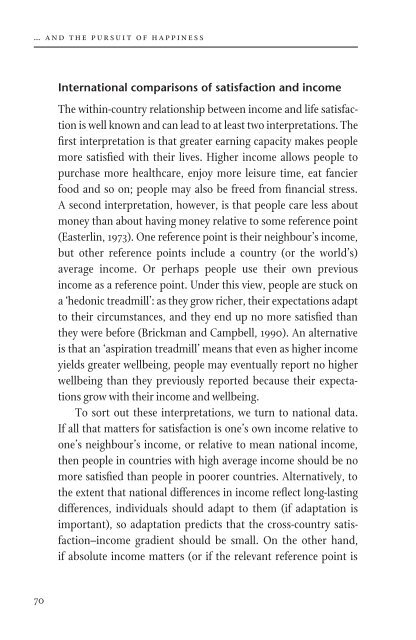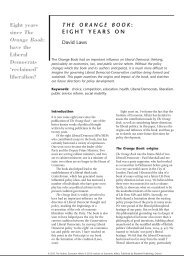… and the Pursuit of Happiness - Institute of Economic Affairs
… and the Pursuit of Happiness - Institute of Economic Affairs
… and the Pursuit of Happiness - Institute of Economic Affairs
You also want an ePaper? Increase the reach of your titles
YUMPU automatically turns print PDFs into web optimized ePapers that Google loves.
<strong>…</strong> <strong>and</strong> <strong>the</strong> pursuit <strong>of</strong> happiness<br />
subjective wellbeing<br />
International comparisons <strong>of</strong> satisfaction <strong>and</strong> income<br />
The within-country relationship between income <strong>and</strong> life satisfaction<br />
is well known <strong>and</strong> can lead to at least two interpretations. The<br />
first interpretation is that greater earning capacity makes people<br />
more satisfied with <strong>the</strong>ir lives. Higher income allows people to<br />
purchase more healthcare, enjoy more leisure time, eat fancier<br />
food <strong>and</strong> so on; people may also be freed from financial stress.<br />
A second interpretation, however, is that people care less about<br />
money than about having money relative to some reference point<br />
(Easterlin, 1973). One reference point is <strong>the</strong>ir neighbour’s income,<br />
but o<strong>the</strong>r reference points include a country (or <strong>the</strong> world’s)<br />
average income. Or perhaps people use <strong>the</strong>ir own previous<br />
income as a reference point. Under this view, people are stuck on<br />
a ‘hedonic treadmill’: as <strong>the</strong>y grow richer, <strong>the</strong>ir expectations adapt<br />
to <strong>the</strong>ir circumstances, <strong>and</strong> <strong>the</strong>y end up no more satisfied than<br />
<strong>the</strong>y were before (Brickman <strong>and</strong> Campbell, 1990). An alternative<br />
is that an ‘aspiration treadmill’ means that even as higher income<br />
yields greater wellbeing, people may eventually report no higher<br />
wellbeing than <strong>the</strong>y previously reported because <strong>the</strong>ir expectations<br />
grow with <strong>the</strong>ir income <strong>and</strong> wellbeing.<br />
To sort out <strong>the</strong>se interpretations, we turn to national data.<br />
If all that matters for satisfaction is one’s own income relative to<br />
one’s neighbour’s income, or relative to mean national income,<br />
<strong>the</strong>n people in countries with high average income should be no<br />
more satisfied than people in poorer countries. Alternatively, to<br />
<strong>the</strong> extent that national differences in income reflect long-lasting<br />
differences, individuals should adapt to <strong>the</strong>m (if adaptation is<br />
important), so adaptation predicts that <strong>the</strong> cross-country satisfaction–income<br />
gradient should be small. On <strong>the</strong> o<strong>the</strong>r h<strong>and</strong>,<br />
if absolute income matters (or if <strong>the</strong> relevant reference point is<br />
mean global income), we would expect richer countries indeed<br />
to be more satisfied. Thus we now assess <strong>the</strong> satisfaction–income<br />
gradient across countries.<br />
Our measure <strong>of</strong> average income in a country is GDP per<br />
capita, measured at purchasing power parity, to adjust for international<br />
differences in price levels. These data come from <strong>the</strong><br />
World Bank’s World Development indicators database. Where<br />
we are missing data, we turn to <strong>the</strong> Penn World Tables (version<br />
6.2), <strong>and</strong>, failing that, <strong>the</strong> CIA Factbook. For earlier years for<br />
which data are unavailable, we use Maddison (2007).<br />
The World Values Survey contains within it some data<br />
problems, such as <strong>the</strong> wellbeing survey not being representative<br />
in some countries. Typically, <strong>the</strong>y tend to miss out groups that<br />
might be expected to have low satisfaction. This survey shows a<br />
general pattern <strong>of</strong> wellbeing increasing with income: <strong>the</strong> countries<br />
with <strong>the</strong> unrepresentative wellbeing data, however, do not tend<br />
to follow <strong>the</strong> general pattern. It is also true that <strong>the</strong> early waves<br />
<strong>of</strong> <strong>the</strong> survey, which contain mostly wealthy nations, provide only<br />
suggestive, but not overwhelming, evidence for a positive link<br />
between <strong>the</strong> log <strong>of</strong> GDP per capita <strong>and</strong> subjective wellbeing. A<br />
researcher who mistakenly included <strong>the</strong> non-representative countries<br />
<strong>and</strong> who plotted satisfaction against <strong>the</strong> level ra<strong>the</strong>r than <strong>the</strong><br />
log <strong>of</strong> income could well (erroneously) fail to find a statistically<br />
significant relationship between GDP per capita <strong>and</strong> subjective<br />
wellbeing. Successive waves <strong>of</strong> <strong>the</strong> survey included more middle<strong>and</strong><br />
low-income countries, <strong>and</strong> <strong>the</strong> relationship between income<br />
<strong>and</strong> wellbeing is clearer in those later waves. The four waves span<br />
25 years <strong>and</strong> 79 distinct countries, with income ranging from less<br />
than $1,000 to over $32,000 (in 2000 international US dollars).<br />
There is a clear <strong>and</strong> approximately linear-log relationship<br />
70 71












